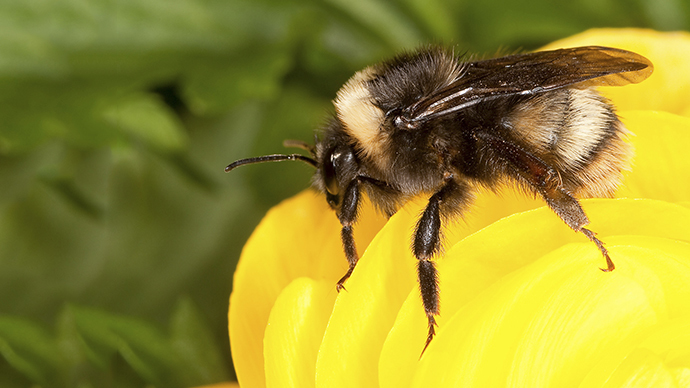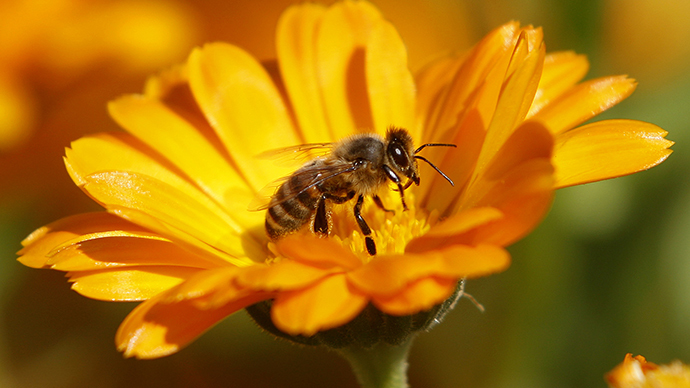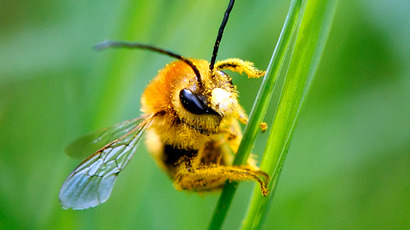Half of European bumblebees in decline, quarter face extinction – study

Almost one-quarter of European crops’ vital pollinators – bumblebees – could die out in the coming years, as half of the species are declining, a new study says. Citing human factor and climate change, it warns of “serious implications” for agriculture.
A preview of the recent European Commission-funded study,
published on the website of the International Union for
Conservation of Nature (IUCN) on Wednesday, says it has some
“bad news” for Europe’s bumblebees.
As much as 46 percent of the 68 bumblebee species living in
Europe have a declining population and just 13 percent are
increasing in numbers, the study shows. According to IUCN, 24
percent of those species are “threatened with
extinction.”
The study, which contributes to the European Red List of
pollinators and is part of the Status and Trends of European
Pollinators (STEP) project, stresses that three of the five
“most important insect pollinators of European crops”
are bumblebee species.
Bumblebees have for thousands of years played a “critical
role” in agriculture as they help crops reproduce by
transferring pollen from plant to plant. However, as agriculture
and urban development have intensified in recent years and
cultivated land has been changed, bumblebees have been hit by the
loss of habitat and the loss of their preferred forage, as well
as pollution and insecticides.
The population of critically endangered Bombus cullumanus, for
example, has declined by more than 80 percent over the last
decade alone, according to the study. Once widespread in Europe,
the so-called Cullum’s Bumblebee now survives only “in a few
scattered locations,” much due to the mass removing of its
favorite clovers from farming practices.
A beef-up in agriculture has also been blamed by the study’s
authors for the shrinking population of the endangered Bombus
fragrans (Steppe Bumblebee), whose native habitat is being
“destroyed” in Ukraine and parts of Russia.
Increasing temperatures and long periods of drought brought about
by climate change are also responsible for “major
changes” in the insects’ habitat. Those species living in
Arctic and sub-Arctic regions, like the Scandinavian tundra and
Russia’s extreme north, are vulnerable to a dramatic decline, the
study concludes.
‘22 billion euro a year’
Scientists have been “very concerned” with the findings
of the study, Ana Nieto, European biodiversity officer of IUCN
and the study’s coordinator, said, adding that “such a high
proportion of threatened bumblebees can have serious implications
for our food production.”
According to Simon Potts, coordinator of STEP, this shows an
increasing threat to Europe’s “natural capital,” an
essential part of which is “the contribution of bumblebees to
food security and the maintenance of wider plant biodiversity.”
The study itself offers an even more striking assessment of this
“capital.”
Together with other pollinators, bumblebees contribute “more
than 22 billion euros [over US$30 billion] to European
agriculture per year,” according to IUCN.
The EU’s top environment official, Janez Potocnik, said the EU
has already banned or restricted the use of certain pesticides
dangerous for pollinators, but their efforts “clearly need to
be scaled up.”
Potocnik believes the solution lies in “mainstreaming of
biodiversity into other policies” and in raising awareness
about the benefits that bumblebees bring.
According to Nieto, the negative trends can be reversed by
“protecting bumblebee species and habitats, restoring
degraded ecosystems and promoting biodiversity-friendly
agricultural practice.”
More precisely, such measures may include “increasing the
margins and buffer strips around agricultural fields that are
rich in flowers and wildlife and the preservation of
grasslands.”
Calls for awareness of bumblebees’ plight come as the EU strategy
to halt biodiversity loss remains under review. The previously
approved plan, set by EU leaders in March 2010, must be
“fully implemented,” IUCN has stressed.

.














